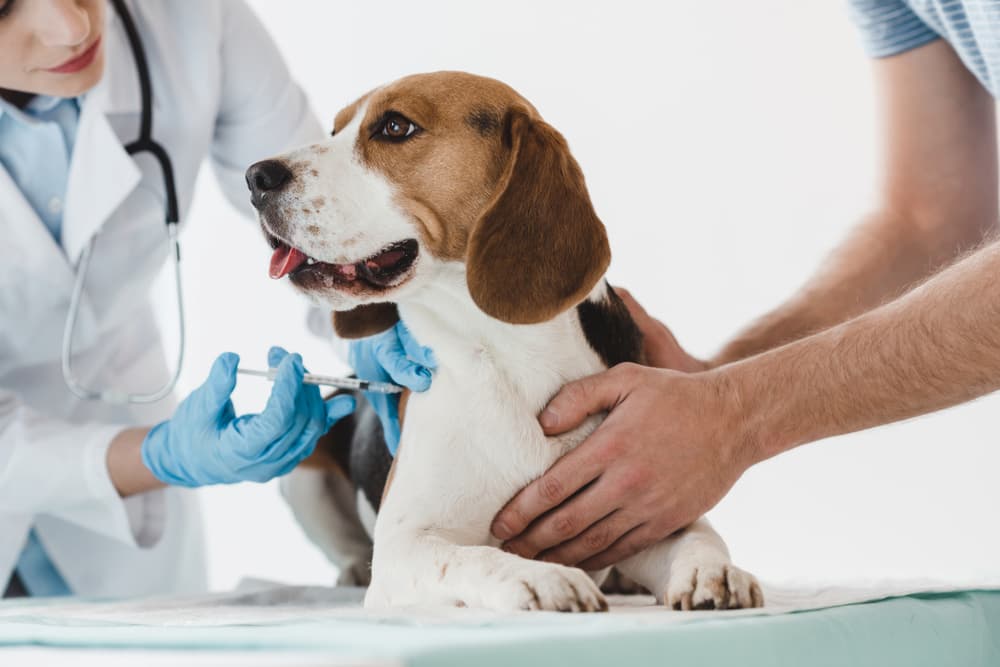Can Dogs Get the Flu?

When it’s flu season, it sometimes feels like there are so many different viruses flying around, you can’t possibly escape coming down with something. If your dog has a cough and symptoms of flu, you might be wondering if they caught flu from you, or whether you can catch it from them. And is it even really “flu” or just a doggy cold?
Let’s look at whether dogs can get the flu, and how you can keep your canine companion healthy this season.
Can Dogs Get the Flu?

In 2004, researchers found Greyhounds infected with an influenza A virus, which they named canine influenza virus (CIV) (1). This H3N8 dog influenza virus originated in horses before mutating so that it could infect dogs (2). This flu strain spread in kennels and shelters, but has been on the decline in recent years—it may even not be in the U.S. anymore.
There’s also another influenza virus strain that dogs can catch: H3N2. It originated in Asia (likely in birds) before crossing the species barrier and infecting dogs. This strain arrived in the U.S. around 2015 (3), and sporadic outbreaks are relatively common.
Typically, infection with either flu virus causes mild signs. That being said, if a dog ends up with secondary pneumonia, it can be more serious and it is possible for dog flu to be fatal.
Although there are canine flu viruses, most cases of dogs having flu-like symptoms are not caused by an influenza virus. Other viruses like parainfluenza virus, adenovirus, and herpesvirus cause respiratory symptoms similar to canine flu.
What Causes Flu in Dogs?
True flu in dogs is caused by canine influenza virus. A virus is a type of microbe, but unlike bacteria, it isn’t alive and cannot replicate without infecting a host. It’s a small piece of DNA (or RNA) coated in protein. In influenza, the two surface proteins hemagglutinin (H) and neuraminidase (N) help us to identify which flu virus we’re talking about. Dogs have two flu viruses currently known: H3N8 and H3N2.
Both types of canine flu virus are thought to have started out in other species—the H3N8 probably came from horses, and the H3N2 likely from birds. The viruses are now considered canine-specific. Although both types of flu are infectious to dogs, neither has been known to infect humans (4). It’s thought that the likelihood of a pandemic caused by canine flu is low.
Just like human flu, canine flu spreads from dog to dog in respiratory droplets when a dog sneezes or coughs. It can also spread through contact with contaminated surfaces, such as shared water bowls, dog toys, or surfaces in kennels. Humans can also spread canine flu from dog to dog on their hands and clothes.
Like many canine respiratory diseases, canine flu spreads easily where dogs are housed in close confinement, such as in kennels or shelters. All dog breeds are equally susceptible, but it’s slightly more common in breeds that are often housed in groups, such as Greyhounds and Beagles.
Some dogs are more likely to get serious flu than others. These are dogs who already have lung, heart, or respiratory problems, such as short-snouted breeds or those with congestive heart failure.
Dog Flu Symptoms

The symptoms of dog flu are similar to other causes of respiratory disease in dogs. Some dogs show no signs of having caught dog flu (they are asymptomatic) but others can be more seriously ill. Your dog might be coughing and/or have a runny nose and eyes, but the cough is very similar to kennel cough or a canine cold. Like humans, dogs with flu may feel lethargic. Other dog flu symptoms include:
- Cough
- Runny nose
- Sneezing
- Runny eyes
- Lethargy
- Fever
- Reduced appetite
Unfortunately, many of these symptoms are similar to other diseases, such as kennel cough, canine colds, and even seasonal allergies. Due to these similarities, it can be very difficult to determine exactly what is causing your dog’s symptoms at home. Since there is no specific treatment for canine flu, this doesn’t actually matter day to day. However, if your dog seems under the weather with their symptoms, you should head to the vet to get a diagnosis and any necessary treatment.
In some cases, dogs with flu will get a secondary infection. This is where they come into contact with another microbe that causes respiratory disease and—because their immune system is weakened by the virus—the microbe has more of an effect. For instance, Bordetella bronchiseptica, the bacteria sometimes responsible for kennel cough, will often complicate a dog flu infection and increase the chances of a dog becoming more seriously ill with pneumonia.
Diagnosing Flu in Dogs
In most cases, diagnosis of flu in dogs isn’t necessary. It’s very similar to a number of other contagious respiratory diseases and treatment is the same regardless of the exact microbe causing your dog’s illness.
It’s likely your vet will examine your dog thoroughly to rule out other causes of a cough, then diagnose canine infectious respiratory disease complex (CIRDC). This essentially means your dog has a respiratory infection, but there’s not necessarily a known cause. At this point, the infection could be caused by a virus like flu or parainfluenza, or a type of bacteria. In some cases, dogs will be infected with more than one cause of contagious respiratory disease at once.
If there’s a high risk of spread to other dogs or a dog is particularly sick, a vet might request a more specific test to diagnose the cause of your dog’s symptoms. These tests may include:
- X-rays (to look for other causes of a cough)
- Ultrasound (to check the heart more thoroughly, where heart disease is suspected)
- Nose or mouth swab
- Bronchoalveolar lavage (BAL) or tracheal wash
Nasal and oral swabs are easy to perform but sometimes inaccurate. The nose and mouth of dogs can contain many bacteria that aren’t causing disease, so differentiating what is causing the symptoms can be difficult.
The best test is a bronchoalveolar lavage (BAL), which samples deep inside the lungs, where there should be fewer confusing bacteria and viruses. For this test, your dog will need an anesthetic. Sterile saline is pushed into their lungs through a tube, then drawn back out. The liquid is then sent to a laboratory to be checked under a microscope and the DNA of the sample checked to see which viruses and bacteria are present.
How to Treat Dog Flu

In many cases, dogs with the flu won’t need treatment. Their symptoms are often very mild, and they recover on their own in under two weeks.
If your dog has been ill for less than a week and they have mild signs of dog flu, you can treat them at home with supportive care. This involves keeping an eye on their appetite, temperature, and other symptoms to look for deterioration. You may want to put them in the bathroom with the shower running for a little while—the steam can help a cough. Avoid neck collars, as these can irritate the trachea and worsen a cough, and try to remove bark triggers wherever you can. This might mean closing the curtains so your dog can’t see the street.
If your dog has symptoms for more than a week, or starts with more severe symptoms such as a fever, lethargy, or decreased appetite, you should contact a veterinarian. Your dog may require antibiotics to clear a secondary infection. In addition, your vet may provide a cough suppressant and an anti-inflammatory for you to give at home. In most cases, these dog flu treatments are easy to give, but please talk to your veterinarian if you’re concerned about your ability to medicate your dog.
In severe cases, your dog might be hospitalized for oxygen therapy and nebulization. They may also require fluid therapy and/or nutritional support if they haven’t been eating or drinking enough.
Medications for Dog Flu
There are no specific medications to treat dog flu. If treatment is needed, it’s usually for a secondary bacterial infection. Your dog may be prescribed antibiotics, cough suppressants, or anti-inflammatories.
General Cost of Treatment
Treating dog flu is usually low cost, and most cases will resolve without any treatment at all. If treatment is needed, most dogs can be managed at home and costs are likely to consist of your initial visit, some medications, and a re-examination ($100-$400).
If tests and hospitalization are required, the bill will often be higher. In these cases, treating dog flu costs are likely to be $300-$1,400.
Don’t forget, you can always request a breakdown of expected costs from your veterinarian. Let your vet know if you have budget constraints, as they will be happy to work with you to make sure you can still do the best for your dog.
Dog Flu Prevention

There are vaccines available against both strains of canine flu. Like human flu vaccines, the dog flu shot doesn’t prevent the disease, but will reduce the severity of symptoms and help your dog to recover from infection faster. Vaccination isn’t compulsory and the dog flu vaccine will usually only be offered to at-risk dogs. This includes those that often mix with other dogs (shelter dogs, pack dogs, breeding dogs, Greyhounds, and show dogs) and those with heart disease, lung disease, or a short snout (which would make an infection more likely to be serious).
Other than vaccination, normal hygiene precautions can help prevent the spread of dog flu. Don’t let your dog mix with dogs of unknown vaccination status, and choose kennels based on their hygiene practices. Take care to wash your hands and your clothes if you have been in contact with a dog with symptoms of dog flu.
Related Conditions
- Kennel cough
References
- Payungporn S, Crawford PC, Kouo TS, et al. Influenza A Virus (H3N8) in Dogs with Respiratory Disease, Florida. Emerging Infectious Diseases. 2008;14(6):902-908. doi:10.3201/eid1406.071270.
- Reagan KL, Sykes JE. Canine Infectious Respiratory Disease. Vet Clin North Am Small Anim Pract. 2020;50(2):405-418. doi:10.1016/j.cvsm.2019.10.009
- Centers for Disease Control. Canine Influence (Dog Flu) Outbreak in Chicago Area. April 2015. Retrieved from https://www.cdc.gov/flu/news/dog-flu-chicago.htm
- Centers for Disease Control. Key Facts About Canine Influenza (Dog Flu). Retrieved from: https://www.cdc.gov/flu/other/canine-flu/keyfacts.html









